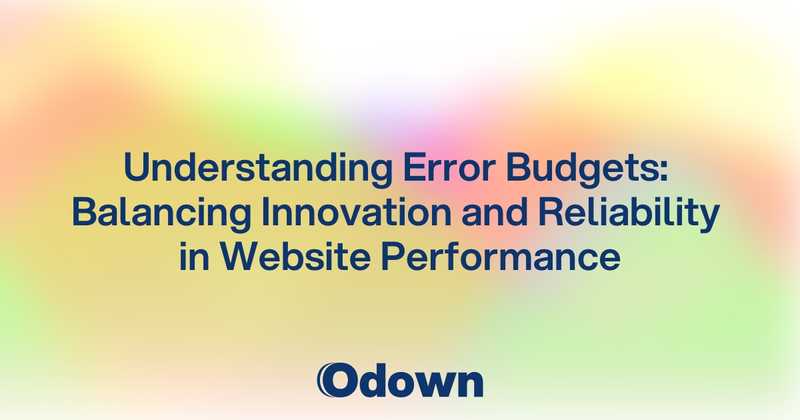Understanding Error Budgets: Balancing Innovation and Reliability in Website Performance
In the high-speed world of web development and digital service delivery, teams face a perpetual dilemma: pushing new features quickly versus ensuring system stability. This tension often creates friction between development teams focused on innovation and operations teams concerned with reliability. Error budgets offer a solution to this conflict by providing a framework that allows controlled risk-taking while maintaining acceptable service reliability.
This guide explores error budgets in depth, explaining how they can transform your approach to website performance management, software delivery, and team alignment around reliability goals.
What Are Error Budgets and Why Do They Matter?
An error budget is a quantifiable allowance for service degradation or failures within a defined time period. In simpler terms, it's the maximum amount of downtime, errors, or performance issues your service can experience before you need to prioritize reliability work over new feature development.
The Fundamental Concept
Error budgets work on a simple principle: 100% reliability is neither practical nor necessary for most services. Instead, teams define a Service Level Objective (SLO) that's less than perfect---for example, 99.9% availability---and the gap between this target and 100% becomes your "budget" for taking risks, experimenting, and introducing changes.
Key Components of Error Budgets:
- Service Level Indicators (SLIs): Measurable metrics of service performance (availability, latency, error rate)
- Service Level Objectives (SLOs): Target values for your SLIs (e.g., 99.9% availability)
- Error Budget: The mathematical difference between your SLO and 100% perfection
- Error Budget Policies: Pre-agreed actions when budgets are depleted
Benefits of Implementing Error Budgets
Organizations that effectively implement error budgets typically see several significant advantages:
- Balanced Decision-Making: Data-driven approach to balancing innovation speed with reliability
- Reduced Team Friction: Objective framework that aligns development and operations goals
- Controlled Risk-Taking: Clear boundaries for acceptable experimentation
- Improved User Experience: Focus on metrics that actually impact users
- Proactive Reliability Work: Encourages preventative maintenance before problems affect users
Real-World Example
Consider a company operating an e-commerce platform with a 99.9% uptime SLO, measured monthly. This translates to approximately 43 minutes of allowed downtime per month. If by mid-month they've only experienced 10 minutes of downtime, they have 33 minutes remaining in their error budget, giving them confidence to deploy new features. However, if they've already had 40 minutes of issues, they should focus on reliability improvements instead of new functionality.
Setting Effective Error Budgets for Website Performance
Creating meaningful error budgets requires thoughtful selection of metrics and thresholds that align with both business objectives and user experience expectations.
Choosing the Right SLIs for Your Website
While availability is the most common metric for error budgets, modern websites require a more nuanced approach. Consider these potential SLIs for website performance:
Availability Metrics:
- Success Rate: Percentage of requests returning non-error responses
- Uptime: Time your service is accessible to users
- Failed Transaction Rate: Percentage of core user flows that fail
Performance Metrics:
- Time to First Byte (TTFB): Server response time
- First Contentful Paint (FCP): Time until first content appears
- Largest Contentful Paint (LCP): Time until main content appears
- Time to Interactive (TTI): When users can interact with the page
User Experience Metrics:
- Cumulative Layout Shift (CLS): Visual stability measurement
- First Input Delay (FID): Responsiveness to user interaction
- Conversion Rate Stability: Consistency in business-critical conversions
Determining Appropriate SLO Targets
Setting SLO targets involves balancing user expectations, business requirements, and technical capabilities:
- Historical Performance Analysis: Review past performance data to understand what's realistic
- Competitive Benchmarking: Assess industry standards and competitor performance
- User Experience Impact: Determine thresholds where users notice degraded performance
- Business Impact Alignment: Consider the cost of reliability versus the cost of downtime
- Technical Constraints: Account for architectural limitations and infrastructure capabilities
Sample Error Budget Framework for Website Performance
| Metric | SLI Measurement | SLO Target | Error Budget Allocation |
|---|---|---|---|
| Availability | % of successful requests | 99.95% | 0.05% (21.9 min/month) |
| Latency | % of requests under 200ms | 95% | 5% of requests can exceed threshold |
| LCP | % of page loads under 2.5s | 90% | 10% of page loads can exceed threshold |
| CLS | % of page loads with CLS < 0.1 | 85% | 15% of page loads can exceed threshold |
Implementing Error Budget Policies
For error budgets to be effective, they must be accompanied by clear policies that dictate actions when budgets are approaching depletion or are exhausted.
Creating Actionable Policies
Effective error budget policies should include:
- Measurement Methodology: How and when budgets are calculated
- Alerting Thresholds: When teams are notified about budget consumption
- Escalation Procedures: Who needs to be informed at various consumption levels
- Response Actions: Specific steps to take when budgets reach critical levels
- Exemption Processes: Handling exceptional circumstances requiring policy override
Sample Error Budget Policy
Service: Corporate Website
Measurement Period: Calendar Month
Budget Based On: 99.9% Availability SLO
// CONSUMPTION THRESHOLDS AND ACTIONS
50% Budget Consumed:
- Alert sent to engineering leadership
- Review recent deployments and incidents
- No action required beyond awareness
75% Budget Consumed:
- Temporary freeze on non-essential feature deployments
- Daily review of deployment plans and risk assessments
- Increase monitoring sensitivity
90% Budget Consumed:
- Complete feature deployment freeze
- Focus engineering resources on reliability improvements
- Incident review meeting to identify systemic issues
100% Budget Consumed:
- Emergency reliability review with executive team
- Implementation of action plan to address root causes
- Post-incident review with all stakeholders
// EXEMPTION PROCESS
Emergency deployments during budget freeze require:
- Written approval from CTO or VP of Engineering
- Documented risk assessment
- Rollback plan and testing
Monitoring and Enforcing Error Budgets
Effective implementation requires continuous monitoring and strong organizational commitment:
- Automated Measurement: Implement real-time tracking of SLIs
- Dashboards and Visualization: Make budget consumption visible to all stakeholders
- Alerting Integration: Configure alerts at key consumption thresholds
- Budget Burn Rate Tracking: Monitor consumption velocity, not just total
- Post-Incident Budget Analysis: Evaluate how incidents affect remaining budget
For a deeper understanding of monitoring requirements and implementation strategies, refer to our Website Monitoring for GDPR Compliance guide, which provides valuable insights on maintaining compliance while implementing comprehensive monitoring systems.
Advanced Error Budget Strategies
As organizations mature in their use of error budgets, several advanced strategies can further enhance their effectiveness.
Multi-Dimensional Error Budgets
Instead of a single error budget based on availability, mature organizations often implement multi-dimensional error budgets:
- Critical Path Budgets: Stricter budgets for business-critical functions
- Regional Budgets: Different budgets for different geographic regions
- Customer Tier Budgets: Varied reliability targets based on customer importance
- Feature-Specific Budgets: Different allocations for different features based on criticality
Error Budget Investment
When teams consistently maintain reliability within budget, they can "invest" the unused budget in controlled risk-taking:
- Chaos Engineering Sessions: Deliberate failure injection for resilience testing
- Large-Scale Refactoring: Taking on technical debt reduction with higher risk
- Architecture Experimentation: Testing new architectural approaches
- Accelerated Feature Development: Temporarily increasing deployment velocity
Continuous Error Budget Refinement
Error budgets should evolve with your service and user expectations:
- Periodic SLO Reviews: Quarterly reassessment of SLO targets
- SLI Expansion: Adding new metrics as monitoring capabilities improve
- Seasonal Adjustments: Modifying budgets during high-traffic periods
- Competitive Realignment: Adjusting targets based on market changes
- User Feedback Integration: Refining thresholds based on user satisfaction data
Error Budget Implementation Case Studies
Learning from real-world implementations provides valuable insights into effective error budget strategies.
E-Commerce Platform Implementation
Challenge: An e-commerce company struggled with balancing rapid feature deployment and site reliability, especially during high-traffic sales events.
Approach:
- Implemented error budgets based on three key metrics: availability, checkout success rate, and page load time
- Created seasonally adjusted budgets with stricter targets during peak shopping periods
- Developed automated dashboards showing real-time budget consumption
Results:
- 47% reduction in critical incidents during peak seasons
- Improved development team autonomy during periods of healthy budget
- Better prioritization of reliability work before major sales events
- Reduced tension between operations and development teams
Content Publishing Platform Case Study
Challenge: A major content platform experienced frequent performance degradations after deployments, affecting user engagement metrics.
Approach:
- Implemented performance-focused error budgets based on LCP, CLS, and engagement metrics
- Created separate budgets for front-end and back-end teams
- Introduced graduated deployment freezes based on budget consumption
Results:
- 68% reduction in post-deployment performance issues
- More focused and effective performance optimization work
- Improved accountability for code performance across teams
- Better alignment between business goals and reliability targets
Organizational Change and Error Budget Adoption
Successfully implementing error budgets requires more than technical solutions---it demands organizational changes and leadership support.
Building Team Consensus
Error budgets work best when both development and operations teams view them as valuable tools rather than punitive measures:
- Collaborative SLO Development: Include all stakeholders in setting initial targets
- Education and Training: Ensure everyone understands the purpose and mechanics
- Shared Ownership: Make reliability everyone's responsibility, not just operations
- Success Celebration: Recognize teams that effectively manage their budgets
- Continuous Feedback Loop: Regularly review and adjust based on team input
Executive Sponsorship and Alignment
Error budget implementation requires strong executive support:
- Executive Education: Ensure leadership understands the concept and benefits
- Clear Reliability Objectives: Connect error budgets to business outcomes
- Resource Commitment: Provide time and tools for implementation
- Consistent Enforcement: Support policy decisions even when inconvenient
- Recognition Systems: Reward teams that prioritize reliability appropriately
Common Implementation Challenges
Be prepared to address these typical obstacles:
- Resistance to Feature Freezes: Development teams may resist deployment restrictions
- Measurement Accuracy Questions: Debates about SLI accuracy and relevance
- Budget Gaming: Attempts to work around budget policies
- Inconsistent Enforcement: Selective application undermining the system
- Over-Optimization: Excessive focus on metrics rather than actual user experience
Conclusion: Building a Reliability-Focused Culture with Error Budgets
Error budgets transform reliability from a binary "works/doesn't work" mentality to a nuanced approach that acknowledges acceptable risk and balances it with innovation needs. When implemented effectively, they create a culture where:
- Reliability becomes a shared responsibility across all teams
- Data drives decisions about when to prioritize features versus stability
- Teams gain autonomy within clear guardrails
- User experience consistently meets expectations
- The organization can take calculated risks with confidence
By implementing error budgets as part of your website performance strategy, you establish an engineering culture that values both innovation and reliability, ultimately delivering better user experiences while maintaining the pace of development your business requires.
The most successful implementations start small, with a few key metrics and simple policies, then evolve as the organization gains experience and confidence in the approach. Begin your error budget journey today and transform how your teams think about reliability and performance.



